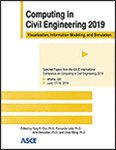ASCE International Conference on Computing in Civil Engineering 2019
Identifying Damage-Related Social Media Data during Hurricane Matthew: A Machine Learning Approach
Publication: Computing in Civil Engineering 2019: Visualization, Information Modeling, and Simulation
ABSTRACT
Previous research used keywords like Hurricane Matthew/Sandy to filter the disaster- and damage-related social media data. However, various Twitter data containing these keywords were not describing the disaster events or their impacts. Meanwhile, machine learning demonstrates its potential for classifying social media data. Nevertheless, very limited existing research employs this approach for identifying damage-related social media data. This paper introduces the machine learning approach for identifying the damage-related social media data. Naïve Bayes, support vector machine (SVM), and decision tree are employed for training the classifier. The 10-folder cross-validation method is utilized for evaluating the performance of these three classifier models. Naïve Bayes model demonstrates the most reliable results. This paper provides a new solution for filtering the damage-related social media data during natural disasters. The manually annotated Twitter data can be used for classifying social media data in future disaster events.
Get full access to this article
View all available purchase options and get full access to this chapter.
REFERENCES
Chapin, F.S. (1975). “Human activity patterns in the city: things people do in time and in space.” Soc. Indic. Res.,2 (2), 261–264.
Chawla, N. V., Bowyer, K. W., Hall, L. O., and Kegelmeyer, W. P. (2002). “SMOTE: synthetic minority over-sampling technique.” Journal of artificial intelligence research, 16, 321-357.
Forman, G. (2003). “An extensive empirical study of feature selection metrics for text classification”. The Journal of Machine Learning Research, 3, 1289-1305.
Gal-Tzur, A., Grant-Muller, S. M., Kuflik, T., Minkov, E., Nocera, S., and Shoor, I. (2014). “The potential of social media in delivering transport policy goals.” Transport Policy, 32, 115-123.
Garg, M., and Kumar, M. (2016). “Review on event detection techniques in social multimedia.” Online Information Review, 40(3), 347-361.
Gonçalves, P., Araújo, M., Benevenuto, F., and Cha, M. (2013). “Comparing and combining sentiment analysis methods.” Proc., the first ACM conference on Online social networks, ACM, Boston, MA, 27-38.
Gu, Y., Qian, Z. S., and Chen, F. (2016). “From Twitter to detector: Real-time traffic incident detection using social media data.” Transportation research part C: emerging technologies, 67, 321-342.
Guan, X., and Chen, C. (2014). “Using social media data to understand and assess disasters.” Natural hazards, 74(2), 837-850.
Kaur, H. J., and Kumar, R. (2015). “Sentiment analysis from social media in crisis situations.” Proc., 2015 International Conference on Computing, Communication & Automation, Noida, India, 251-256.
Kryvasheyeu, Y., Chen, H., Obradovich, N., Moro, E., Van Hentenryck, P., Fowler, J., Cebrian, M. (2016). “Rapid assessment of disaster damage using social media activity.” Sci. Adv., 2 (e1500779), pp. 1-11.
Mullen, T., and Collier, N. (2004). “Sentiment analysis using support vector machines with diverse information sources.” Proc., the 2004 conference on empirical methods in natural language processing, Barcelona, Spain.
Ovadia, S. (2009). “Exploring the potential of Twitter as a research tool.” Behavioral & Social Sciences Librarian, 28(4), 202-205.
Pang, B., Lee, L., and Vaithyanathan, S. (2002). “Thumbs up?: sentiment classification using machine learning techniques.” Proc., the ACL-02 conference on Empirical methods in natural language processing, Association for Computational Linguistics, Philadelphia, PA, 79-86.
Spence, P. R., Lachlan, K. A., and Rainear, A. M. (2016). “Social media and crisis research: Data collection and directions.” Computers in Human Behavior, 54, 667-672.
Sriram, B., Fuhry, D., Demir, E., Ferhatosmanoglu, H., and Demirbas, M. (2010). “Short text classification in twitter to improve information filtering.” Proc., the 33rd international ACM SIGIR conference on Research and development in information retrieval, Geneva, Switzerland, 841-842.
Wang, Q., and Taylor, J. E. (2015). “Process map for urban-human mobility and civil infrastructure data collection using geosocial networking platforms.” Journal of Computing in Civil Engineering, 30(2), 04015004.
Yuan, F., and Liu, R. (2018a). “Feasibility study of using crowdsourcing to identify critical affected areas for rapid damage assessment: Hurricane Matthew case study.” International journal of disaster risk reduction, 28, 758-767.
Yuan, F., and Liu, R. (2018b). “Integration of Social Media and Unmanned Aerial Vehicles (UAVs) for Rapid Damage Assessment in Hurricane Matthew.” Proc., Construction Research Congress 2018, New Orleans, LA, 513-523.
Yuan, F., and Liu, R. (2018c). “Crowdsourcing for forensic disaster investigations: Hurricane Harvey case study.” Natural Hazards, 93(3), 1529-1546.
Zou, L., Lam, N. S., Cai, H., and Qiang, Y. (2018). “Mining Twitter Data for Improved Understanding of Disaster Resilience.” Annals of the American Association of Geographers, 108:5, 1422-1441.
Information & Authors
Information
Published In
Computing in Civil Engineering 2019: Visualization, Information Modeling, and Simulation
Pages: 207 - 214
Editors: Yong K. Cho, Ph.D., Georgia Institute of Technology, Fernanda Leite, Ph.D., University of Texas at Austin, Amir Behzadan, Ph.D., Texas A&M University, and Chao Wang, Ph.D., Louisiana State University
ISBN (Online): 978-0-7844-8242-1
Copyright
© 2019 American Society of Civil Engineers.
History
Published online: Jun 13, 2019
Authors
Metrics & Citations
Metrics
Citations
Download citation
If you have the appropriate software installed, you can download article citation data to the citation manager of your choice. Simply select your manager software from the list below and click Download.
